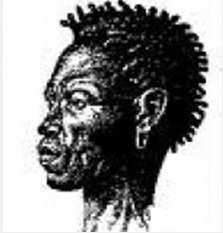 During the XIIIth and XIVth centuries in Africa, lived the Jagas, respected warrior tribes or nations. Portuguese called them Jagas or Imbengalas, those tribes coming from Sierra Leone. Jagas could eat beef or goat meat but their favourite one was human meat.
During the XIIIth and XIVth centuries in Africa, lived the Jagas, respected warrior tribes or nations. Portuguese called them Jagas or Imbengalas, those tribes coming from Sierra Leone. Jagas could eat beef or goat meat but their favourite one was human meat.
The population reached around 12 000 Black people. They were not settled in a definite area and their thirst for conquest led them until Southern Angola, following Guinean Gulf’s littoral. At the same period, other warrior tribes existed, such as the Anzicos, who also participated in the waves of destruction of Congo (Zaïre), forcing sometimes the Congolese kings to hide themselves.
Those barbarians attacked by surprise the populations, assailing everything which was on their way, burning and destroying everything. The camps were built in a circular and concentric shape. They looked for resting areas, in the best case situated close to a cliff. The chief was responsible for choosing the strategic places where to settle, the safest possible. The main leader lived at the camp’s centre, under the protection of two guards. The chief was isolated from his neighbours by steps and bars, each officer or leader had a special importance in each section. In each quarter, houses were very close to one other, which provided a good level of protection.
Everyone kept his weapons at his room’s door: this was to be quickly ready to attack or defend, with all the members of the Quilombo. They lived in areas where grew a lot of palming tree, of which they extracted oil. They fed themselves with fruits and wine. Most of the time, they did not stay long at each place, but that could happen if they had specific plans: for instance at harvest season they stayed a little longer. They attacked and stole other people’s cattle, as they didn’t want to rear themselves. They managed to find their daily food thanks to their attacks against surrounding populations.
Their main force was surprise. They had an operational and efficient tactic. When they were attacked, their defensive strategy was to abandon two or three warriors to the enemy to calm down the offensive then to come back short after with many men. Their opponents could not challenge with those strong attacks and those tricks. The ambushes took place almost always at night. Their squadrons attacked simultaneously on both sides, and dominated therefore their enemies. They were tall and strong men, well-equipped with knives, arrows, bows, azagaias, spears, shields, etc..
Women did not raise their own children; they adopted teenagers caught during the wars. New-born babies were abandoned in fields. The young captives took part to the battles, they were ordered to bring back their enemies’ heads as a proof of their manhood and submission to the Jaga chief. Once they had did it, the young warriors could become free men, Jagas.
Arrived from Congo’s Nothern coast, the king Zimbon (Jaga) divided his army. One of his wives, named Temba-Nduma, went through Sierra Leon, Quizuva and later failed to conquish Mozambique, losing the war against the Portuguese in Tété. King Zimbo had also been defeated in Melinde, on his way to settle in Matamba (Angola inlands) in 1570. At the moment, local villages gathered together and gave birth to Imbangola or Imbangala people, at the end of XVth century.
They created several kingdoms: Huila, Humbi and Matamba, they went down until Cassange and Benguela passing North of Cunene. Later, they conquered Ndongo’s kingdom and his son Ngola Kiluanji I. Thus, appeared the generation of the famous Queen Ginga de Matamba, in Angola.




